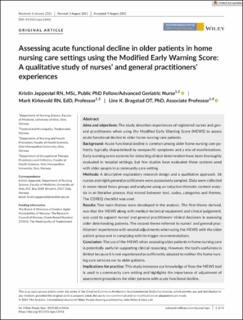| dc.contributor.author | Jeppestøl, Kristin | |
| dc.contributor.author | Kirkevold, Marit | |
| dc.contributor.author | Bragstad, Line Kildal | |
| dc.coverage.spatial | Norway | en_US |
| dc.date.accessioned | 2021-09-30T13:53:26Z | |
| dc.date.available | 2021-09-30T13:53:26Z | |
| dc.date.created | 2021-08-24T15:05:19Z | |
| dc.date.issued | 2021-08-24 | |
| dc.identifier.citation | International Journal of Older People Nursing. 2021, 1-11. | en_US |
| dc.identifier.issn | 1748-3735 | |
| dc.identifier.issn | 1748-3743 | |
| dc.identifier.uri | https://hdl.handle.net/11250/2786708 | |
| dc.description.abstract | Aims and objectives: The study describes experiences of registered nurses and general practitioners when using the Modified Early Warning Score (MEWS) to assess acute functional decline in older home nursing care patients. Background: Acute functional decline is common among older home nursing care patients; typically characterised by nonspecific symptoms and a mix of manifestations. Early warning score systems for detecting clinical deterioration have been thoroughly evaluated in hospital settings, but few studies have evaluated these systems used with older people in a community care setting. Methods: A descriptive exploratory research design and a qualitative approach. 36 nurses and eight general practitioners were purposively sampled. Data were collected in seven mixed focus groups and analysed using an inductive thematic content analysis in an iterative process that moved between text, codes, categories and themes. The COREQ checklist was used. Results: Two main themes were developed in the analysis. The first theme derived, was that the MEWS along with medical-technical equipment and clinical judgement, was used to support nurses’ and general practitioners’ clinical decisions in assessing older deteriorating patients. The second theme referred to nurses’ and general practitioners’ experiences with several adjustments when using the MEWS with the older patient group and in complying with its trigger recommendations. Conclusion: The use of the MEWS when assessing older patients in home nursing care is potentially useful in supporting clinical reasoning. However, the tool's usefulness is limited because it is not experienced as sufficiently adapted to neither the home nursing care services nor to older patients. Implications for practice: This study increases our knowledge of how the MEWS tool is used in a community care setting and highlights the importance of adjustment of assessment procedures for older persons with acute functional decline. | en_US |
| dc.description.sponsorship | This study was funded under the Public Sector PhD scheme by The Research Council of Norway (Project number 273141), the Municipality of Tvedestrand and The Board of Directors of eastern Agder Municipalities of Norway. | en_US |
| dc.language.iso | eng | en_US |
| dc.publisher | Wiley | en_US |
| dc.relation.ispartofseries | International Journal of Older People Nursing; | |
| dc.rights | Attribution-NonCommercial-NoDerivatives 4.0 Internasjonal | * |
| dc.rights.uri | http://creativecommons.org/licenses/by-nc-nd/4.0/deed.no | * |
| dc.subject | Assessments | en_US |
| dc.subject | Clinical decision-making | en_US |
| dc.subject | Content analyses | en_US |
| dc.subject | Decision-making | en_US |
| dc.subject | Evidence-based practices | en_US |
| dc.subject | Home care | en_US |
| dc.subject | Older people | en_US |
| dc.title | Assessing acute functional decline in older patients in home nursing care settings using the Modified Early Warning Score: A qualitative study of nurses’ and general practitioners’ experiences | en_US |
| dc.type | Peer reviewed | en_US |
| dc.type | Journal article | en_US |
| dc.description.version | publishedVersion | en_US |
| dc.rights.holder | © 2021 The Authors. | en_US |
| dc.source.articlenumber | e12416 | en_US |
| cristin.ispublished | true | |
| cristin.fulltext | original | |
| cristin.qualitycode | 1 | |
| dc.identifier.doi | http://doi.org/10.1111/opn.12416 | |
| dc.identifier.cristin | 1928389 | |
| dc.source.journal | International Journal of Older People Nursing | en_US |
| dc.source.pagenumber | 1-11 | en_US |

